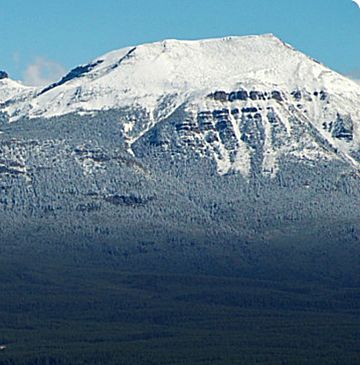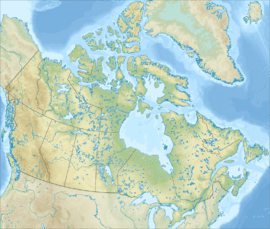Lipalian Mountain facts for kids
Quick facts for kids Lipalian Mountain |
|
|---|---|
 |
|
| Highest point | |
| Elevation | 2,682 m (8,799 ft) |
| Prominence | 152 m (499 ft) |
| Parent peak | Redoubt Mountain (2902 m) |
| Listing | Mountains of Alberta |
| Geography | |
| Location | Alberta, Canada |
| Parent range | Slate Range Canadian Rockies |
| Topo map | NTS 82N/08 |
Lipalian Mountain is a mountain peak in Banff National Park, Alberta, Canada. It stands 2,682-metre (8,799-foot) tall. This impressive mountain is part of the Slate Range within the larger Canadian Rockies. It was named in 1958 by William C. Gussow. The name "Lipalian" comes from a geological idea about a time when there were no fossils, proposed by a scientist named Charles Walcott.
Contents
Understanding Lipalian Mountain's Rocks
The mountains in Banff National Park, including Lipalian Mountain, are made of sedimentary rock. This type of rock forms from layers of sand, mud, and tiny bits of plants and animals that settle over millions of years.
How the Rocks Formed
- These rocks were first laid down in shallow seas a very long time ago. This happened during periods known as the Precambrian and Jurassic eras.
- Later, huge forces deep within the Earth pushed these rock layers. This event is called the Laramide orogeny. It caused the rocks to fold and break, creating the towering mountains we see today.
Exploring Lipalian Mountain's Climate
Lipalian Mountain experiences a subarctic climate. This means it has very cold, snowy winters and mild summers.
Winter Weather on the Mountain
- During winter, temperatures can drop really low, sometimes below -20 °C (which is -4 °F).
- When the wind blows, it can feel even colder, with wind chill making it feel like -30 °C (-22 °F) or even colder.
- The Lake Louise Ski Resort is located nearby, to the northwest of the mountain. This area is known for its heavy snowfall, making it a great spot for winter sports.

All content from Kiddle encyclopedia articles (including the article images and facts) can be freely used under Attribution-ShareAlike license, unless stated otherwise. Cite this article:
Lipalian Mountain Facts for Kids. Kiddle Encyclopedia.


